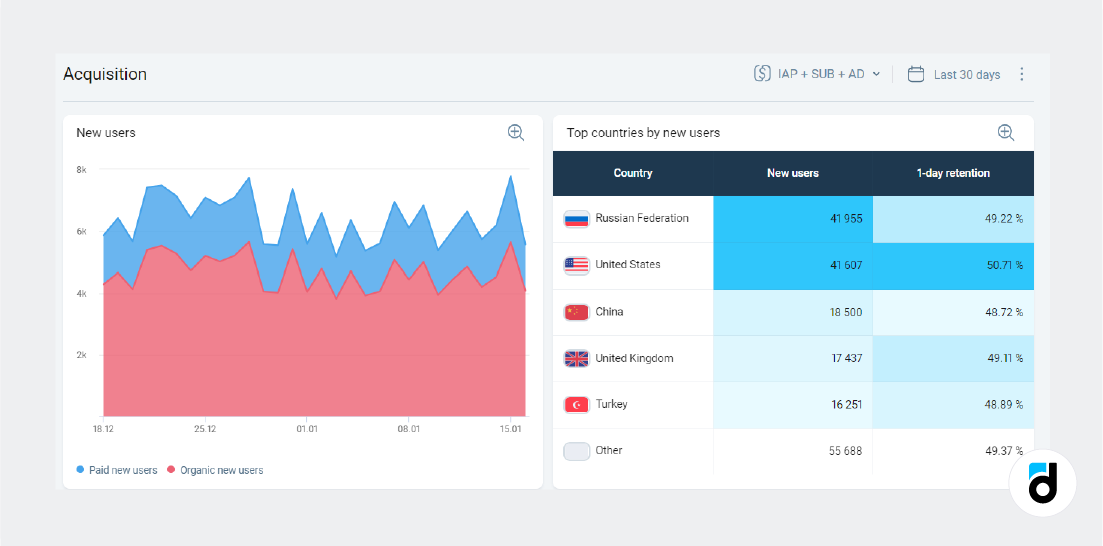In the world of app and game development, understanding acquisition metrics is crucial for success. From tracking the number of downloads to calculating the Return On Investment (ROI), each metric provides valuable insights into the effectiveness of your acquisition strategies. Let's dive into some key metrics, why they matter, how to calculate them on the analytics platform, and ways to improve them.
Downloads
Downloads refer to the total number of times an app has been downloaded to a user's device within a specific timeframe. It's a foundational metric indicating user interest and campaign effectiveness.
Some analytics platforms allow for further segmentation of the acquired data by countries, devices, sources, etc. They may allow users to differentiate this metric even further - into first time downloads and redownloads. Other platforms don’t imply it at all and consider downloads as installs. We won’t stop at this metric as it is closely related to the installs metric.
Installs and New Users
While downloads represent the acquisition of the product, installs measure the actual installation on a user's device, and new users - the number of users who opened the app for the first time.
These metrics provide insights into how many users found the product valuable enough to go through the installation process. A high installation rate suggests that users are interested in the product and are willing to invest time and device space to try it out.
Monitoring installs and the number of new users can help companies understand the conversion rate from downloads to installation and actual app testing, allowing for targeted optimization of installation and user onboarding processes. Like download metrics, they help analyze the effectiveness of marketing campaigns.
Read more: Main Metrics. Installs
How to Calculate in devtodev
Devtodev only measures the number of new users. An overview of the metric can be found in the Acquisition -> Dashboard and Acquisition -> Monitoring section. The number is conveniently broken down into paid and organic user traffic.

Or you can calculate it for the desired period in Reports -> Basic metrics -> New users.
You can analyze data using various filters such as ad campaigns, countries, devices and more to optimize user acquisition channels and personalize the user experience to better meet the needs of specific target audiences.
Walk through devtodev demo
Ways to Improve
How to increase downloads and installs:
- Optimize app store presence with ASO (App Store Optimization).
- Encourage positive reviews and word-of-mouth referrals.
- Utilize paid acquisition strategically for targeted user acquisition.
Virality or K-factor
At the heart of understanding virality lies a key metric: the K-factor, also known as the "virus index" or "virality index." This metric quantifies the rate at which users invite others and how many of those invitations lead to actual installations.
How to Calculate
The formula is straightforward yet impactful:
K-factor = Sent invites * Conversion
Here, "Sent invites" represents the average number of invitations sent by a user, and "Conversion" is the rate at which those invitations turn into actual installs.
Understanding the K-factor opens doors to predicting user growth cycles. The number of new users brought in through virality can be calculated in subsequent cycles:
- New users (1) = Active users * K-factor
- New users (n) = New users (n-1) * K-factor
As the K-factor increases, so does the pace of audience expansion. This ripple effect continues as new users invite their friends, who then invite others, creating a snowball effect of growth.
Read more: Main metrics. K-factor
Ways to Improve
Increasing the K-factor involves strategic steps:
- Allow users to invite friends with enticing incentives.
- Create shareable, high-quality content that users are eager to spread.
- Provide users with the ability to easily share their achievements inside an app via social networks.
Return On Investment (ROI)
ROI, or Return on Investment, is a fundamental metric that not only measures the effectiveness of your strategies, but also sheds light on the quality of traffic sent to your project.
ROI can also be thought of as an acquisition metric, although it doesn't say much about acquisition per se. Essentially, ROI is a metric that shows you how much return you get on the money you invest.
How to Calculate
There are a few ways to calculate ROI for your app or game, each offering insights into the profitability of your endeavors:
Basic formula:
ROI = (Revenue – Investments) / Investments
A positive ROI indicates that your investment has paid off.
Simplified approach:
ROI = (Revenue / Investment) * 100%
In this calculation, the ratio ROI > 100% will indicate payback.
Ways to Improve
How to optimize ROI:
- Monitor user behavior metrics like ARPU, retention, and conversion.
- Compare ROI for different channels to allocate resources effectively.
- Consider NPV and IRR for long-term investment planning and evaluation.
Conclusion
Acquisition metrics like Downloads, Installs, K-factor, and ROI provide a comprehensive view of your app's performance. By leveraging tools like devtodev and focusing on these metrics, developers and marketers can refine their strategies, improve user acquisition, and drive sustainable growth in the competitive app market.











































































































































































































































































































































